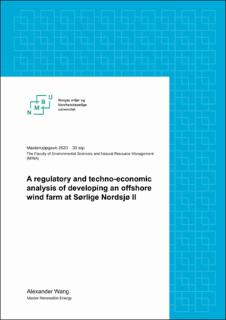| dc.description.abstract | The European Commission recently presented a strategy proposal to increase Europe’s offshore wind capacity to 60GW by 2030 and to 300GW by 2050. Along with strong wind resources, Norway has a tremendous opportunity to utilize its vast offshore oil and gas experience to the development of offshore wind. This transformation would enable a potential value creation of up to NOK 117 billion while simultaneously contributing to reduce greenhouse gas emission (Winje et al., 2019). Consequently, OED opened the Norwegian offshore areas Utsira Nord and Sørlige Nordsjø II for the development of a domestic offshore wind market (Olje-og-Energidepartementet, 2020). This master thesis investigates the techno-economic and regulatory feasibility of developing a 550MW offshore wind farm in the area Sørlige Nordsjø II. Such feasibility studies for a specific offshore wind farm in Norway is lacking in academia and hence the author intends to fill this gap.
The regulatory framework for offshore wind development in Norway is laid out in the Ocean Energy Law and the Ocean Energy Act. Other sector relevant laws and authorities are also required to be considered when developing offshore wind at Sørlige Nordsjø II. There is still uncertainty surrounding the licensing process and export cables which needs to be addressed. OED plans to release a guideline in spring 2021 which needs to clarify these regulatory issues.
Although in harsh sea conditions with water depths between 60-70m, it was found to be technically feasible to use four-legged jacket bottom-fixed foundation. The foundation is optimal for the seabed in the area which is characterized by sand and clay. Covering an area of 44 〖km〗^2, the 550MW wind farm is connected via 66kv array cables between 55 Siemens Gamesa SG 11-193 DD Flex turbines, each with a rated capacity of 11MW. Along with the wind data provided by Stormgeo, the offshore wind farm was simulated in WindPRO and was used to calculate a net AEP of 2.5 TWh.
The economic feasibility of the 550MW was assessed in three scenarios. Scenario 1, 2, and 3 is solely transmitting and selling the electricity to Norway, Germany, or U.K, respectively. Scenario 1 resulted in a positive NPV to equity after taxes of NOK 261,885,405. Scenario 2 resulted in a positive NPV to equity after taxes of NOK 2,497,911,190. Finally, scenario 3 resulted in a positive NPV to equity after taxes of NOK 4,303,294,971. All three scenarios were therefore economically feasible. That said, scenario 3 is the recommended option for the offshore wind farm due to the comparatively greater potential NPV and IRR. Last, LCOE was calculated at 0.52 NOK/kWh, which is in line with expected LCOE for bottom-fixed projects. | en_US |

